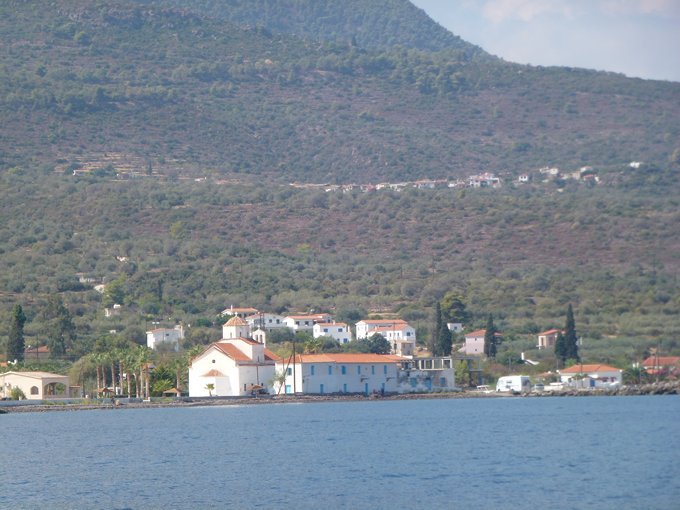37:38.27N 23:09.47E Palaia Epidhavros

37:38.27N 23:09.47E Palaia Epidhavros
Wednesday, 19th September, 2012.
A very heavy rain storm at 3 in the morning wake us up quickly as the hatches were open and suddenly after weeks of no rain it was giving us a good soaking. We enjoyed our fish dinner so much last night I was sent to the fish market for some more today. Jim washed the boat as we have water on the quay. He washed the sides as we bought a new handle for the special soft brush we have and as it extends so he managed to do a great job which he was happy with.
Along with Bluestar we have decided to visit the theatre at Epidaurus which is 30 minutes by taxi from the small port. We had hoped to sail but we were motor sailing it is again out past the very sheltered bays of Navy, Neorion and Russian and round the point of Nedha. We followed the large Methana Peninsula along the east coast and round the north coast and headed west for Epidhavros.
Methana appears very quiet with small hamlets here and there along the coast line. The pine trees spread for miles up and down the various mountains. It is joined to the Peloponnese by a narrow isthmus and is twice the size of Poros. Methana looks beautiful but the harbour is known as the “stinking shore” as sulphuretted hydrogen bubbles up in the harbour and gives off the rotten-egg smell. The buildings on the west side of the harbour house sulphur baths and people suffering with rheumatic diseases pay to visit them. We were told if you can stand the smell you can have a free bath in the harbour!
We saw two groups of dolphins while we were sailing along Methana. All appeared to be herding and feeding. The second group had at least 12 good size dolphins.
The excitement didn’t finish with the dolphins as we found tuna jumping and splashing as we came around the north side of Methana. Jim had a couple of tugs on the line but unfortunately it was not to be our lucky day.
Les and Sue of Bluestar motored in before us and were stars and found us a place on the quay at Epidhavros by asking a catamaran to move over slightly and we were safely tied up very quickly.
Once we were ready we caught a taxi to the Epidaurus theatre which is roughly 30 minutes away. The taxi driver gave us an hour to look around and be back at the drop off point. After buying our tickets we decided to make straight for the theatre and leave the museum and viewing of the Sanctuary of Asklepios to later just in case we ran out of time.
The theatre was designed by Polyketios the Younger late in the 4th century BC and it is well known for the near-perfect acoustics and during the summer it is used for concerts and festivals of ancient drama. As the sanctuary was relatively remote its masonry was never pilfered and it remained undiscovered until the 1970’s. It has the only circular orchestra stage where they performed to have survived but the altar which once stood in the centre has gone. The pillars on each side which gave the actors and actresses access to the stage have had their pillars re-erected. Behind the orchestra and facing the auditorium stand the remains of the main reception hall which was used by the performers as an extension of the stage.
The round orchestra was 66 feet in diameter. There were 34 rows in the lower half of the theatre which date to the 4th century BC and 21 rows above that which was added in the Roman period. The theatre is 374 feet across and is divided into blocks by 36 staircases. We walked up to the top and Jim counted 109 steps. Although some repairs have been done very little has been changed. It could hold 14,000 people all seated. We were very lucky that while we were at the top of the theatre an American girl sang for her parents and the sound was marvellous. Everyone couldn’t help but clap her.
Greek drama developed from ritual role play at festivals and then dancing with groups dressed as animals. The first Greek theatres appeared in the late 6th century BC and the actors wore masts to express the personality of the characters they played. Statuettes were made for the performances and were often sold off at the end of the shows.
We found the museum very interesting as they had recovered walls and pillars of the Sanctuary of Asklepios and had them reconstructed in the museum along with statues. Although not a big museum the work which has been done is one of the best we have seen. The heavens had opened and we dived in the museum to miss the rain.
We just had time to look over the site of Asklepios and saw the stadium which was used for athletes is having lots of restoring work going on together with preserving the ramp and buckled pavement from the Sacred Way which led north from the gateway to the coastal town of ancient Epidhavros. The therapeutic mineral springs which are still on tap beside the museum were thought to have healing powers for the patients who were brought to the sanctuary. Patients would sleep in a large hall where they would await a diagnostic dream or a visit from the harmless serpents!













